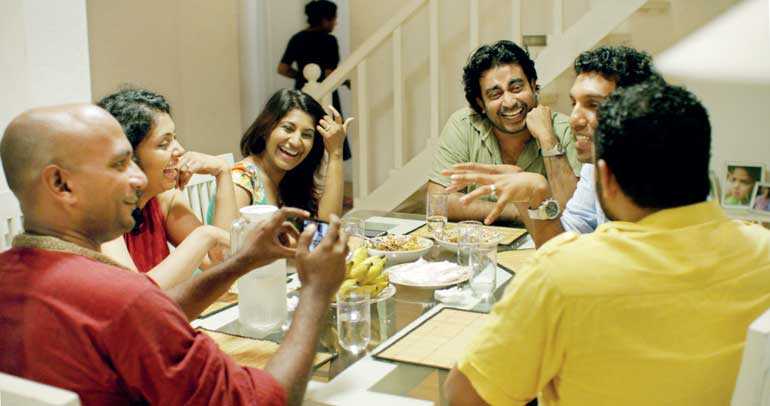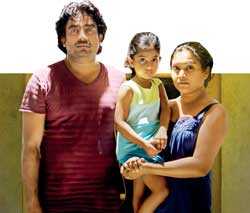Thursday Dec 25, 2025
Thursday Dec 25, 2025
Saturday, 27 April 2019 01:06 - - {{hitsCtrl.values.hits}}

By Dr. Prabha Manuratne
Malith Hegoda’s debut film ‘Dekala Purudu Kenek’ (‘The Strange Familiar’) marks a prominent shift in the portrayal of domesticated sexuality in Sri Lankan cinema. Sinhalese cinema’s obsession with women’s sexuality and male fantasies of feminine power and the femme fatale, have given way, finally, to its logical end, death and its double, the living dead.
In a sensitive portrayal of women’s entrapment in bourgeois marriage, rare in contemporary Sri Lankan cinema, it captures how the new techno-mediated culture and the violent suppression of women’s expressions of freedom and sexuality, create the normative marriage as an institution that drives women to metaphorical, sometimes literal, suicide. The film resonates with novels of Victorian domesticity and its uncanny double of the woman trapped within the home, but with an insidious postmodern twist.
Here, I argue that the film captures the way the home becomes an uncanny place, taking the lead from Freud’s 1919 essay titled ‘The Uncanny’. This text is often evoked in discussions of the horror genre; but unlike in classic gothic, the horror lies in the everyday, the banal, trivialisation of the suppression of women’s sexuality and affective life. My argument is that this film changes the tone of the dominant Sinhala cinema, that, so far, has tried to justify and/or fantasise about a bourgeois marriage that can be sanitised or even liberal, without boldly announcing its demise.

‘Dekala Purudu Kenek’ is a deceptively quaint and controlled film. Its tensed poise captures the way contemporary middle-class marriages are trapped within the decorum of small talk and the violent suppression of the sexual, the intimate, and the emotional; it captures the way bourgeois marriages rely upon deadening routines and success narratives that suffocate the ruins of life embalmed through extravagant weddings and spacious houses.
In this, however, the film does not present a theme that has not been discussed before, and draws on the best classical feminist theoretical and film traditions. What is unique is the way it dabbles with the idea of the uncanny, usually the province of the horror genre. This is the central theme of my reading, as the film’s portrayal of the middle class marriage has been discussed by other critics, notably Upali Amarasinghe and many have commented on the way it captures the entrapment of the woman in bourgeois marriages. But this entrapment has the effect of ‘The Uncanny’ or, the estrangement of the familiar, a theme invoked in the film’s English title.
The narrative, obliquely
Dinithi and Sachitra are a middle-class couple, educated, and married following a four-year love affair. They seem to have been liberal and understanding lovers until, after marriage, Dinithi has an affair, which sets off a spate of jealousy in Sachitra.
The film begins at this point, where Sachitra is trying to control Dinithi, blocking access to any form of communication with the outside world. The physical violence is sparse and controlled, but the emotional abuse is tangible; the tension is built up through the vapid routine that the husband and wife follow, as well as the husband’s quiet control of the wife’s movements and communication.
In contrast to the tamed wife he tries to turn her into, Dinithi is a sexually appealing and forward woman, often overstepping the limits of normative behaviour, but seems to be strangely innocent to her sexual appeal. Her encounters with both the trishaw-driver and her cousin, Sankha, the only two men in her life other than her husband, are full of innuendos. Both reject her advances, which she seems to either not notice or not care about.

The parents on both sides, but especially Dinithi’s father, try to pacify the tensed situation, pointing out that Sachitra should either accept her and love her as his wife, or set her free through a divorce or separation. Sachitra refuses both, and seems to derive a sadistic pleasure from punishing Dinithi, through his quiet demeanour, which simply punishes Dinithi through silence, maintaining a “normalised” routine, and simply holding Dinithi hostage in a normality that denies her, her very being.
Until this point, the film revolved around the theme of marital strife, situated firmly in the domestication of the woman. In an unexpected turn, however, she invites the trishaw driver to the house, claiming she wants a table moved. He is confused and careful, but complies, moving a small wooden table to a store room for her. The film prepares the spectator to a sexual encounter between the two, set up for us by the anticipation of the trishaw-driver as well as what, to us seem like explicit sexual advances by the woman. She offers him a drink, which he politely refuses and leaves, disappointing us.
We return to the store room, where Dinithi is now standing on the table she has just had moved, trying to commit suicide. This is the “Other Scene,” into which the narrative is suddenly derailed. What, up to this point is a question of sexuality and control, now becomes one of death and murder. Even as Dinithi fails to commit suicide, another man dies—presumably instead of her—caused indirectly by Sachitra’s carelessness. Sachitra seems to be a master of the art, to kill without killing, to be only indirectly implied in the murders he commits; even in this, he leaves some space to maintain his innocence.
This is theme of death in film, which rapidly encroaches the filming text—first through Dinithi’s suicide attempt, the accident, and finally the flashback to Dinithi’s dead dog, whom Sachitra kills “accidentally.” Here I argue that we must resist the symbolic dimension of the dog’s accident, as symbolic of how Sachitra would subsequently destroy Dinithi. Instead we must read it as a metonymic chain of “accidents” in which real and metaphorical deaths take place, but obliquely, off-mark. When Sachitra metaphorically kills Dinithi, it is always someone else, a dog a by-passer that dies.
My reading is that the story of Dinithi’s unfaithfulness, her over-sexualisation, and Sachitra’s occasional angry outbursts (he is generally well-composed, and demands a similar normality from Dinithi while constantly suffocating her sexually and emotionally) are traps laid down for us by the film-maker to side-track our attention to the real horror that lies at the heart of the bourgeois home: violence and death.
What is ultimately astounding is the way violence and death appear as “normal” as “routine” as “controlled” entrapment, skilfully delivered through the way the “problem” is always discussed in typical bourgeois fashion: as polite conversations between parents. The outbursts of both Dinithi and Sachitra during these conversations are slated as odd, out-of-tune and off-beat in these rational bourgeois conversations.

The film’s genius lies in the way it laces polite conversations with death, sexuality, and violence. The polite conversations become the weapon, the proverbial bourgeois properness becomes the tool through which Dinithi is pushed to suicide. Ultimately, to Sachitra, it doesn’t matter if Dinithi really had an affair or not; in his eyes, she was a fallen woman from the beginning, deserving his tolerance only because she has mothered his child. As his friends keep reminding him, he is over-reacting to a situation that is common and accepted in the type of corporate set-up in which both Sachitra and Dinithi seem to have worked.
Thus, in the end, it really doesn’t matter if Dinithi was a sinner or Sachitra is a sadist. The core of the film lies in the way its controlled mood conveys how the suppression of affect, sexuality, and intimacy are reframed into uncanny forms of routine and small talk. What are the theoretical implications of this focus on the death at the heart of the bourgeois family?
This final wedding scene, I argue, is what retroactively, makes the familiar estranged and estranging. Its sad extravagance, highlighted through the distracted attention of the characters waving from the screen at the viewer, signals to us that we are caught up in the love-affair of death as we participate in the staging of its crippling entrapment of the woman. It fills us with anxiety, the mechanism through which we ward off the emerging real, in this instance, death.
In this sense, the bourgeois home becomes a trap, a place for staging the “other scene” in which we will no longer sit comfortably, watching other people’s luxuries. It fills the diegetic space with anxiety, anxiety that can hardly protect us from the ur-scene of love—the death of Dinithi’s dog, metonymically capturing Dinithi’s undead death.
The film’s genius lies in its decided restraint when it comes to its metacinematic dimension. It does not commit the sin of over-cleverness, but weaves the metacinematic into the narrative seamlessly, only occasionally resorting to vagaries of symbolism such as the mug, the cross, and the comment on the single-door architecture.
If one feels that the connection I make between the uncanny and this quaintly unghostly film is excessive, the director leaves a nuanced mark for us to read it that way. As Dinithi is engaged in a secret conversation with her lover over the phone, the stairway frames her body posing erotically; the vertically striated frame reminds one of the blinds in Hitchcock’s ‘Psycho,’ a classical cinematic piece on the unheimlich.
This artfully framed shot, along with the title’s explicit reference to the concept, prompts one to read the film as something beyond a domestic tragedy. Taken from this view, the film lays a trap for the viewer: the viewer is made to think that the film is about the domestic drama of betrayal, jealousy, and murder. But, at each turn we are proven wrong (again like ‘Psycho’) making us confront our own desire to see Dinithi sin and be punished.

On the other hand, her eroticised body and over-passive acceptance of her situation enrages us, because we want her to fight back, to walk out of the family, to somehow rock the boat. But the film performs neither, frustrating both the oppressors and the oppressed—those who wish to see women punished for their sexuality and those who wish to see women liberated from the shackles of the home.
For example, the film sets us up to think that Dinithi will sleep with either the trishaw driver or the sexy cousin so that her punishment, now desired by a viewer, can be justified. She does neither, and even more annoyingly, she seems oblivious to her own sexual power. We then hope that she will leave this damning situation, find a life for herself: after all she had once been a career woman.
Similarly, and even more frustratingly, we want Sachitra to either violently dismiss her from the home, or have an affair with the woman who openly offers herself to him; he too refuses to get out of his crippling jealousy and entrapment within the family.
The question the film seems to be asking by setting these various traps is, why is it that people who are perfectly capable of escaping this hell of the home refuse to do so? Again, the film offers various false answers: Dinithi feels that the home will provide her security in her old age, and Sachitra claims that he is doing so for the sake of the child. Neither of which seems adequate responses given the suffering of each within the marriage. The problem seems to lie elsewhere, where the characters are bound to their enslavement.
Death and jouissance in the home
Who enjoys in this theatre of cruelty that is the bourgeois marriage? In formulating the problem of film theory, especially that of apparatus theory of Metz and Commoli, Jaqueline Rose argues that their conception of the film apparatus evades the question of sexual difference. She accuses film theory of limiting the problem of viewing to the question of perception and not framing it in terms of sexual difference:
More crucially, it is only in terms of this fundamental question of how sexual perception and disavowal brought into the metapsychology of film can understood. Yet the concept is used purely with reference to the act of perception and not to the structure of sexual difference in terms of which alone it has any logic. (Rose 218)
So what does bringing the notion of sexual difference into the field of the visual entail, when reading ‘Dekala Purudu Kenek’? 
First and foremost, it is the question of the implied reader of the film, in this text, clearly, the male. As Mulvey argued intelligently, mainstream cinema takes the implied reader to be the male. The film’s drama is seen, despite its sensitivity to the woman’s situation, from the point of view of the male. We are made to identify with Dinithi insofar as she acts as the victim of the situation, never asserting her agency as subject or at least as a free individual. But beneath this veneer of reverence for the male point of view, the film itself struggles to both shut out and reveal the violence of patriarchal monogamous marriage.
As Sachitra’s friends keep reminding him, he is over-reacting, because extra-marital affairs are now common and in some ways inevitable; his Othello-like jealousy of Dinithi’s/other’s jouissance is nothing more than his own subjective investment in his trajectory of failed desire. But the outcome of that violent desire that encounters the other’s sexuality as something denied and excluded to the self, is already caught up in the scene of death.
Dinithi’s suicide attempt, her metonymical death indicated by both the death of the passer-by and the dog are, ultimately, the existence of something other to the fiction of marriage; the “un” in the unheimlich, that latches on to the homeliness of the self. The visually excessive image of the dead dog, with its pink entrails lying nakedly on the road is the moment of the Real in the film. Its excessiveness is what alerts us to its fundamental function in desire. We want somebody to die so that some measure of truth can be gauged from the falsity of marriage.
When Dinithi does not ultimately commit suicide, and returns to a life of repetitious moving between her home and that of her parents (we know that she had left the husband before as well through a bit of conversation in a previous scene where Sachitra’s father urges her to bring her clothes and return home) we know that she, like us, are condemned to live like birds in a gold cage, unable to act out our desire for freedom.
Despite the protaginist’s passivity and the denial of her subjective agency, this refusal of freedom makes the film radical: it announces in one brilliant stroke the decided end of the bourgeois monogamous marriage and the postmodern subject’s narcissistic attachment to its glamourous prisons—marriages, markets, success narratives. Lurking behind them, threatening us is an encounter with the real: that of death and sexuality. 
The obsessive clinging to the mug, thus, is not simply a symbol of love for Dinithi, but the agent of normality, the dirty little secret of her own sexuality that will keep her tied to this otherwise cruel theatre of marriage. Between Sachitra’s cross that seeks a victim to sacrifice and Dinithi’s mug, the single-door family home becomes empty of its symbolic meanings, reminding us that it is nothing but a place of power, sexuality and death.
Sexual difference in the cinematic apparatus is crucial here, as we attempt to confront our own desire and the abjection of the female body brought out through the dog’s death. The viewer posited by the film is one who is caught up in the ideological entrapment of bourgeois marriage, who stages desire as someone else’s scene, but is always framed by a desire to punish the excesses of feminine jouissance.
In the end, encore!
I have argued above that the film’s dabbling in the horror genre, despite it being a domestic film is indicative of a radical questioning of the idea of marriage, whose locus is the home. It is the story of the neurotic subject who tries to hold death and sexuality at bay, by immersing in the banality of everyday life. The film performs a kind of estrangement that condemns us to the prison of the ordinary, made glamorous by the market and the luxuries of other people’s homes we see on TV.

As much as it is familiar, it also estranges us from ourselves, leaving the viewer with a sense of helpless complicity in a diegetic world that waves innocently at as from a wedding picture. It stages the suppression of the sexuality of the woman, to which man can only jealously respond with calm cruelty, so that she will live on, zombified after her metonymic death, and appeal to his moral sense and turn herself into the object of his perverse desire. It is a radical film in this sense, not because it offers an answer, but because it announces an end (I hope) to recent Sinhala cinema’s attempt to fantasise a better, equal, or liberal marriage.
Finally, it is unafraid of acknowledging that the femme fatale and women’s sexual objectification is nothing more than the jealous construction of a male-dominated cinema that has reached the limits of its own hypocrisy. After this, one can only shut the door on the un-homely home or repeat the banality of marriage in an unending circle of movement between various equally toxic homes. Encore, Malith and the crew, as one could fondly say in sad comradeship.
References:
(The writer is a Senior Lecturer, Department of English, University of Kelaniya.)